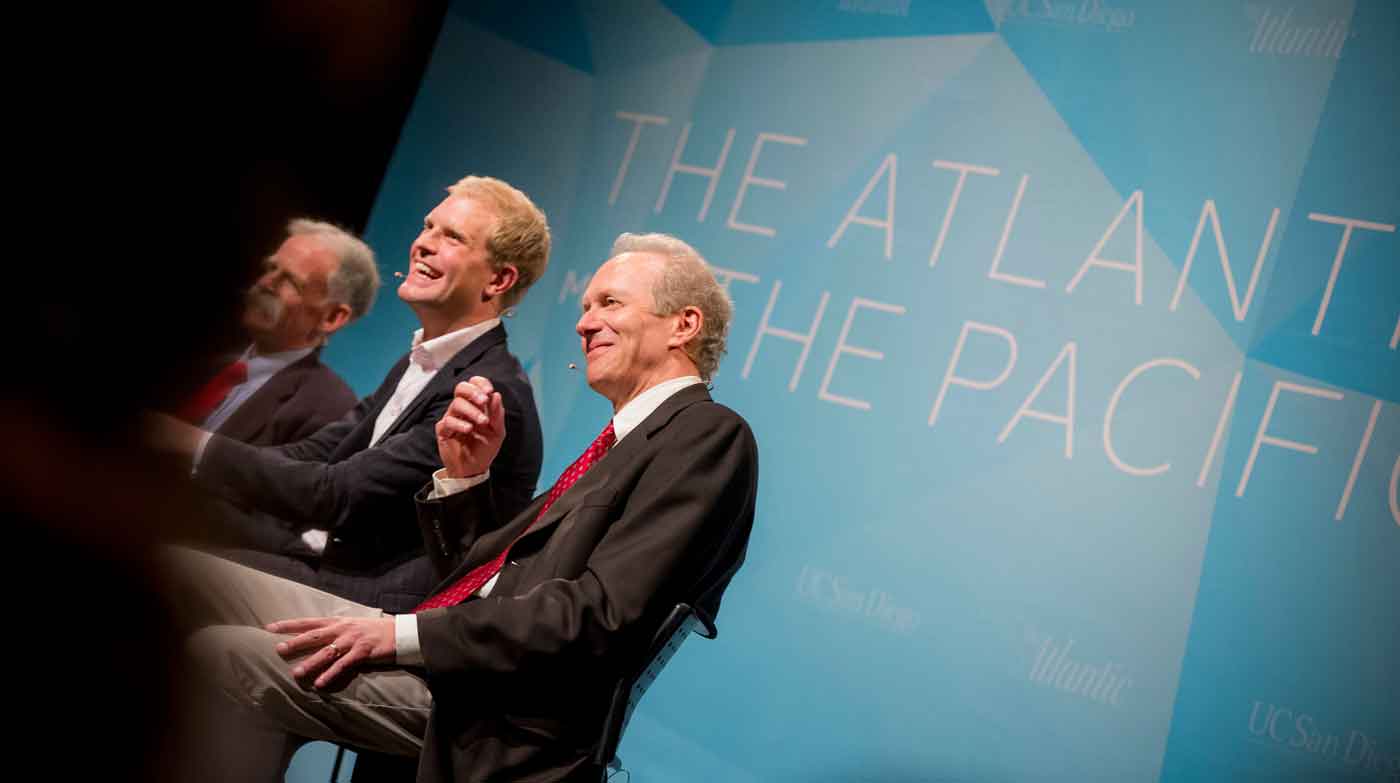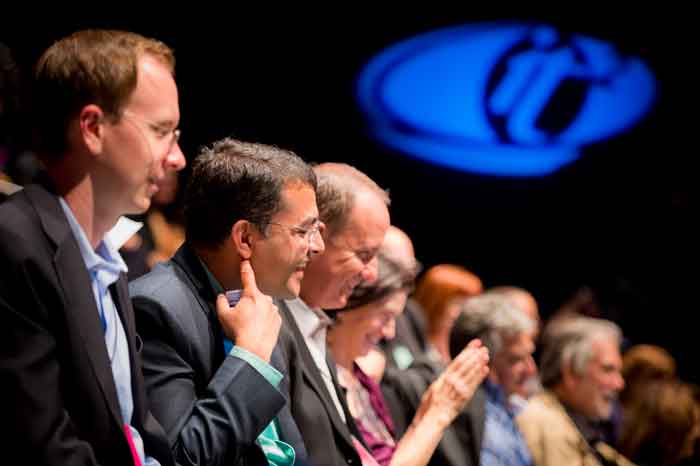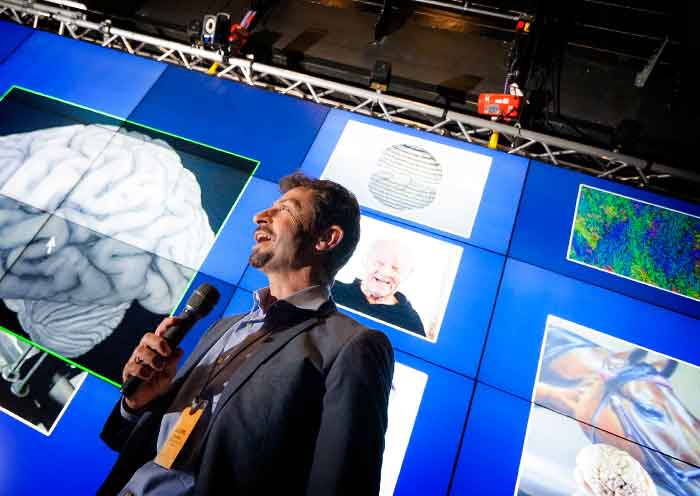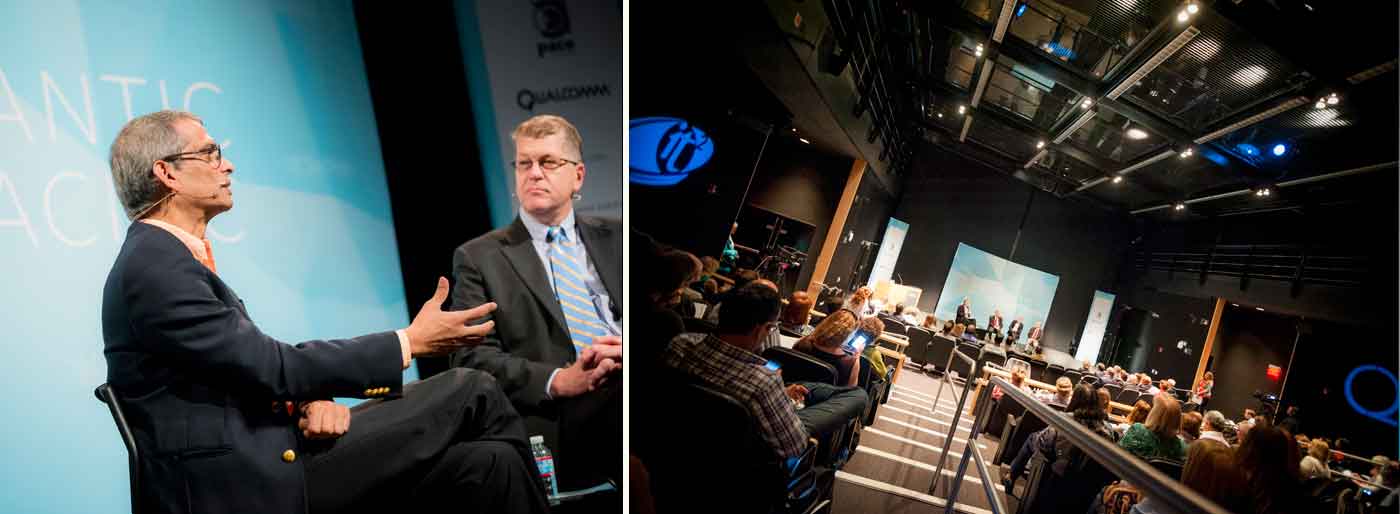
By:
- Tiffany Fox
Published Date
By:
- Tiffany Fox
Share This:
Optimism Meets Pessimism at The Atlantic Meets the Pacific Forum

From right, Ralph Greenspan (Director, Center for Brain Activity Mapping, UC San Diego), Kris Famm (Head, Bioelectronics Research and Discovery Unit, GlaxoSmithKline), Nicholas C. Spitzer (Distinguished Professor of Neurobiology and Co-Director, Kavli Institute for Brain and Mind, UC San Diego) Photos by Erik Jepsen/UC San Diego Publications
If there’s one thing the science, health and technology thought leaders at last week’s The Atlantic Meets the Pacific forum can agree on, it’s this: “Things are going to break a lot more before they get better.”
That sentiment, put into words by Smart Patients CEO and former Google Chief Health Strategist Roni Zeiger, was echoed again and again at the forum by some of the greatest minds from the worlds of academic research, small and big business, clinical medicine and public policy who were interviewed by journalists from The Atlantic magazine.
The third annual forum, which was held Oct. 2 to 4, is a collaboration between The Atlantic and the University of California, San Diego, and follows in the tradition of The Atlantic’s prestigious Aspen Ideas Festival and the Washington Ideas Forum.
This year’s panelists – among them several well known and up-and-coming professors and physicians from UC San Diego (see sidebar) – were all in agreement that the world’s aging population, the advent of ‘smart’ devices and the resulting avalanche of scientific and medical data are creating both overwhelming opportunity and overwhelming challenges for healthcare, and in particular cancer care. It’s not yet clear, however, how quickly the coming revolution will take place, or who will pay for it.
UC San Diego Speakers – The Atlantic Meets the Pacific
-
Ralph J. Greenspan
Director of the Center for Brain Activity Mapping at UC San Diego -
Jacopo Annese
Director of The Brain Observatory at UC San Diego -
Dr. Scott M. Lippman
Director of the UC San Diego Moores Cancer Center -
Nicholas C. Spitzer
Distinguished Professor, Section of Neurobiology -
Ramesh R. Rao
Director of the Qualcomm Institute, UC San Diego division of Calit2 -
Clark Gibson
Professor and former Department Chair of Political Science and Director of the International Studies Program -
Jamie Alexandre
Co-founder of KA Lite and Ph.D. Candidate in Cognitive Science at UC San Diego -
Larry Smarr
Founding Director of the California Institute for Telecommunications
Granted, those in attendance at the forum weren’t feeling especially optimistic given that the event coincided with a Congressional standoff over the nation’s Affordable Care Act, which had by then led to a government shutdown. In an interview with The Atlantic’s Washington Editor at Large Steve Clemons, alternative health advocate Deepak Chopra put the crisis in very Deepak Chopra-like terms: “The biofield of Washington D.C. right now is certainly not coherent.”
Biofields, explained Chopra, are the magnetic fields transmitted by every cell in our bodies, and he claims they can be increasingly measured in scientific ways.
“[You can] correlate states of consciousness with states of biology using mathematical algorithms and correlate that with crime, with hospital admissions, with traffic accidents, with social unrest, with quality of leadership,” he said. “If you all hear the expression, ‘I went into this room, and it was very stressful, you could cut it with a knife, it was so tense,’ or, “I went into this holy temple or this shrine and I felt at peace’ – now we can biologically measure that.”
It’s a theory that no doubt sounds strange to researchers and clinicians used to measuring vital signs like heart rate and blood pressure, not vital signs pertaining to consciousness. But Big Data is forcing Big Medicine to change in big ways, and smart, wireless devices, combined with powerful algorithms, are now able to measure and analyze data that weren’t previously quantifiable.
Take cancer research. Several of The Atlantic Meets the Pacific sessions addressed advances in clinical treatments for cancer, as well as the elements that need to cohere for the many forms of cancer to be cured or, as Sanford Burnham Medical Research Institute CEO Kristiina Vuori put it, “to work toward a solution where cancer might be seen as a chronic disease you can live with.”
An oft-repeated observation at the forum related to the way that the so-called biological ‘-omics’ – genomics, proteomics and metabiomics – are changing the way cancer drugs are developed.
“The whole field of oncology is going through a transition similar to what the Internet went through in the ‘90s,” remarked Dr. Scott Lippman, director of the UC San Diego Moores Cancer Center. “We’re looking now at redefining cancer, and the classic trial designs that we all grew up with don’t really apply now. This is not a vision we have that in 10 to 20 years we’ll get there. It’s happening now. If we identify certain genetic factors in a patient and correlate that with certain drug treatments, we’re seeing dramatic responses.”

Continuing this type of high-impact drug discovery requires adequate and consistent funding, which has traditionally been provided by pharmaceutical companies and government agencies. But with the U.S. government in crisis mode and a potential debt ceiling debacle looming in the wings, those who had taken the stage at the forum expressed great concern that reduced or even eliminated federal funding -- from the National Institutes for Health, especially -- will devastate medical research. Several speakers at the forum called for a doubling of the NIH budget.
Siddhartha Mukherjee, the Pulitzer prize-winning author of “The Emperor of All Maladies: A Biography of Cancer” was adamant in his talk that the U.S. government must make funding for medical research a priority if the world is to benefit from scientific breakthroughs.
“What you cannot do with cancer, or with any scientific project, is you can’t say, ‘Well, you know, we’ve run out of money today, so let’s put it on hold for five years and when the budgets free up and the time happens, we will come back to it.’ That just doesn’t happen,” he said. “Science is a continuous conversation, and if it breaks, it’s a broken conversation. It’s a peculiarity of this ecosystem that while it produces dividends on the one hand, it is actually very fragile.”
Compounding that fragile funding ecosystem is the new occupational ecosystem in which physicians find themselves. Zeiger put the predicament bluntly: “The next 10 years will be the hardest time to practice medicine ever. We know what the future should look like, but the tools are very much very new tools. Medicine will be much more like a team sport. This whole idea of the physician ‘knowing everything’ is just not realistic. Data scientists are going to be a huge part of the healthcare teams of the future.”

Jacopo Annese, Director of the Brain Observatory, UC San Diego
UC San Diego is home to many such data scientists, including neuroscientist Jacopo Annese, who spoke at the forum about his efforts to create one of the world’s most innovative ‘brain banks.’ His Brain Observatory project will preserve a vast archive of human brains together with their medical and life history to create ‘blueprints’ of human cognition. Not only are these slices of human brains useful for understanding pathologies, there are also useful for understanding humans, period.
“I’m interested in whether we can read in this blueprint something unique about a person, to eventually understand what makes a painter a painter, or what makes me, me,” explained Annese, adding that his Brain Observatory project has become so popular that he has had to turn down donated brains.
Ramesh Rao, director of the Qualcomm Institute (the UC San Diego division of the California Institute for Telecommunications and Information Technology), thinks he might know what makes blissful people blissful – or at least he’s developed a way to measure that bliss. Rao’s “Bliss Buzzer” is a device-driven feedback loop that alerts the user (using data pertaining to heart rate variation) when he or she has reached a particularly healthful state, or moment of ‘bliss.’
Rao said he envisions a future where we can “donate our own data when we are healthy, so we can download the data from a past session of yoga and trigger a healthful dance in our heart,” even if our bodies are no longer able to physically do yoga. In other words, said Rao, there might come a time when we can “download our past into our future.”
But for such a breakthrough to come to fruition, the many cogs and wheels of the research and development machine will need to function smoothly. Those waiting on the next technological advance, the next round of funding (or merely for the government to open its doors again) should perhaps follow the advice Rao’s yoga teacher gave him for overcoming obstacles in his own yoga practice: “Go to your edge, pull back and wait for the moment of release. It will come.”

From left, Ramesh Rao (Director of the Qualcomm Institute, UC San Diego) and Steve Clemons (Washington Editor at Large, The Atlantic)
Share This:
You May Also Like
Stay in the Know
Keep up with all the latest from UC San Diego. Subscribe to the newsletter today.


